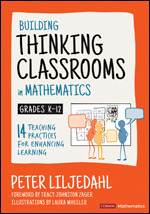Building Thinking Classrooms in Mathematics, Grades K-12
14 Teaching Practices for Enhancing Learning
- Peter Liljedahl - Simon Fraser University
Foreword by Tracy Johnston Zager, Illustrations by Laura Wheeler
Corwin Mathematics Series
A thinking student is an engaged student
Teachers often find it difficult to implement lessons that help students go beyond rote memorization and repetitive calculations. In fact, institutional norms and habits that permeate all classrooms can actually be enabling “non-thinking” student behavior. Sparked by observing teachers struggle to implement rich mathematics tasks to engage students in deep thinking, Peter Liljedahl has translated his 15 years of research into this practical guide on how to move toward a thinking classroom. Building Thinking Classrooms in Mathematics, Grades K–12 helps teachers implement 14 optimal practices for thinking that create an ideal setting for deep mathematics learning to occur. This guide- Provides the what, why, and how of each practice and answers teachers’ most frequently asked questions
- Includes firsthand accounts of how these practices foster thinking through teacher and student interviews and student work samples
- Offers a plethora of macro moves, micro moves, and rich tasks to get started
- Organizes the 14 practices into four toolkits that can be implemented in order and built on throughout the year
“Building Thinking Classrooms prompts us to reflect on the potential of mathematics classrooms, teachers, and learners. Supported by numerous stories from classrooms, Peter methodically exposes the familiar structures of school mathematics that suppress the potential of learners, then carefully outlines a set of opportunities around which teachers of mathematics can organize a dynamic and responsive classroom.”
“Though there are many innovations in the area of teaching mathematics, few speak with a particular lens in terms of setting up an environment where thinking is made visible and public, where positive interdependence is connected to individual and group accountability, and where students rely on their own agency as well as the wisdom of their peers. One where the teacher is freed up to have eyes on all student work, and watch the thinking process in action. In other words, thinking becomes a clearly visible driver in this environment. All of this supports the release of responsibility to the students. It honors their voices, allows for the bumps in learning, and makes the thinking more public, thus supporting and encouraging risk-taking in a safe and supportive environment.”
“This book is timely and provides an accurate portrayal of what is occurring in mathematics classroom across the country. The book is a valuable reflexive tool that teachers can use as they analyze their own teaching practices.”
“Peter’s work in Building Thinking Classrooms has been the single most impactful (driver for) change in secondary mathematics education that I have witnessed. I have never seen another idea/approach/model capture so many teachers immediately, and make it past the point from learning to actual implementation in almost every classroom or instance that I have witnessed.”
“For teachers hoping to transform their teaching practice, Peter has written a definitive source. Peter’s conversational style makes this work both interesting to read and easy to follow. He describes a rich set of practices that will help mathematics teachers transform, in a positive way, everything about their classroom. Peter turns the daunting challenge into something manageable with advice that is both believable and practical.”
The lucid explanations of how children think. The practical and accessible examples.


